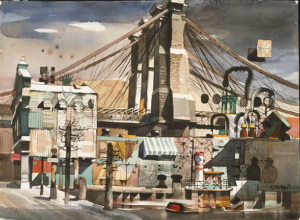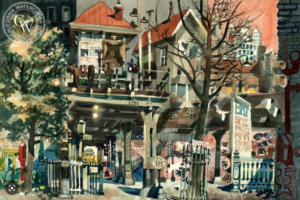In the mid 1980’s, Bob and I had the privilege of visiting the incredible watercolor artist, Dong Kingman, in his home studio on the top floor of a building adjacent to the Park Lane Hotel on Central Park South. We were expecting a grand expansive space with lots of natural light, and instead discovered a rent-controlled apartment with low ceilings and very cramped studio space. Still, it was perfectly adequate for Dong Kingman, a tiny energetic man in his seventies then, who appreciated the prime location and access to the hustle and bustle of Central Park.
We owned a gallery in Five Points South at the time, and hoped to represent his work or even sponsor a show. Kingman, ever the savvy businessman, saw it as an opportunity to sell a painting from his studio. Unfortunately for us, even then, his paintings sold for $5,000 and up and he was represented by major galleries in San Francisco and New York. Nevertheless, it was a fantastic opportunity to view some of the best watercolors of the time and visit with the delightful man who created them!
Although he was born in California, Dong Kingman’s family soon returned to Hong Kong where he attended school throughout his youth. His given name was Dong Moy Shu. However, as was the custom, the names “King” (meaning scenery) and “Man” (meaning composition) were given to him as a child by his teacher upon learning that he hoped to become an artist. He later combined and Americanized the names and became Dong Kingman. His style evolved as he traveled and he became a master at painting urban scenes. His fascination with western modernization combined with his Asian heritage gave him a unique award-winning style.
Bob believes that the Chinese easily master the art of watercolor because they grow up using a brush for creating their alphabet and have an easy facility. However, their technique has been developed over thousands of years. Their brushes are finer and thinner and they learn to create stylized variations of shade and texture. The ink is prepared in various consistencies and diluted depending upon the amount of translucency required. And color is used only to express various feelings, rather than to mimic what the eye sees. Emphasis is given to the expression of the artist’s individuality rather than a factual depiction and the artist’s inscription and seal is considered an important part of this expression.
So Bob thinks he’s at a disadvantage since he’s only been painting for 50 years! His very first art class was at Auburn University which he’s no longer ashamed to reveal that he flunked, but thankfully he perservered. And the European technique taught in this country is still relatively new. Watercolor was not a revered European technique of expression but rather was used for centuries only for sketches and cartoons. It was not until the 18th century when watercolors were the preferred method used for travel journals that the technique became widely popular. Publishing and collecting finally led to the formation of European watercolor societies in the 1800’s.


